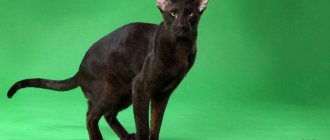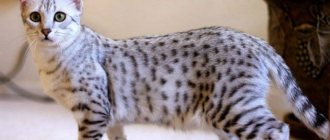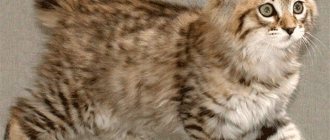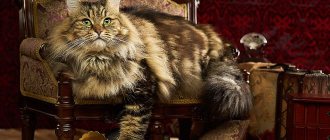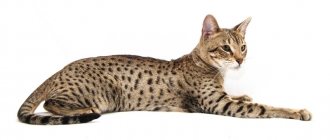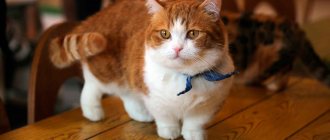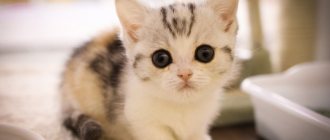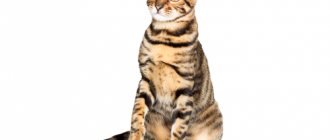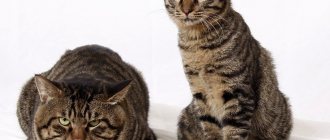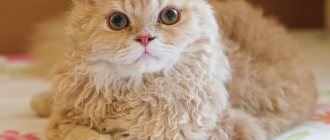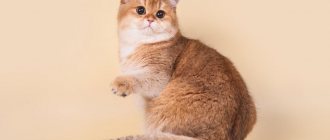Not every cat can boast of the amazing look of beautiful eyes and a flawless white coat. But the Khao Mani cat is distinguished by precisely these qualities. It is not for nothing that she is called the “diamond eye” and is recognized as a champion in cat beauty contests.
Kao-mani wins hearts not only with her brilliant appearance, but also with her golden character. This is manifested in her endless affection, playfulness and devotion to people. Snow-white cats managed to carry and preserve these virtues through the centuries.
Himalayan cat
The breed has a soft Persian coat of Siamese color: on the body it is light or cream, on the tail, paws and face it is darker. The eyes of the “Himalayans” are a clear Siamese blue. Quiet, furry animals prefer home mode and can easily do without walks.
The price of a Himalayan kitten is $500-1300.
British Shorthair
Neat cats with an easily recognizable “cheeky” appearance are extremely independent, silent and reserved. They do not like to be picked up or sat on laps, and do not approach strangers. Self-sufficient "British" cats are considered cats for businessmen who are rarely at home.
The cost of a “British” kitten is $500-1500.
Care instructions
Khao mani do not require special care. It is enough to comb the wool once every 7 days using a regular rubberized brush. This way the dead hairs will be removed, and the cat will get its portion of the massage.
Bathing
Difficulties almost always arise with swimming: khao mani, to put it mildly, do not like water. Moreover, even if you teach them from childhood, it will be difficult to cope with adults. But kao mani cats are very clean, so it will be enough to wipe their paws and body with wet wipes, and wash them once a year (or if the animal gets dirty so much that it cannot wash itself).
Does your cat like to swim?
Not really
Ears
The ears are cleaned with damp cotton pads (soaked in chlorhexidine or ear lotion).
Claws
Claws are trimmed if the cat is too lazy to grind them down on a scratching post (however, this rarely happens).
Teeth
Teeth should be brushed once every 2 weeks, but not every cat will calmly accept this procedure. Some even refuse to let their owner approach them with a toothbrush in their hands.
The best option, of course, is to accustom kao mani to regular cleaning from childhood. Invite the kitten to play with a brush (buy either a special brush or a regular one for children and shorten the bristles), buy a special paste (meat or fish flavored).
This breed belongs to the group of rare and expensive breeds. There are not many nurseries: in their historical homeland - in Thailand, Slovenia, France and in the United States of America. Pet-class babies (exclusively for home care) cost about $10,000. Breeding and exhibition animals - from $20,000. In addition, you will have to pay for delivery and paperwork. There are no nurseries in Russia. You can look for private breeders, but you should choose the seller carefully so as not to “run into” an unscrupulous businessman.
Maine Coon
This huge, powerful breed comes from American farm cats. Males can weigh 15 kg, females - 8. The tufts on their ears give them a lynx-like appearance. By nature, “thugs” are friendly, trainable, and can walk on a leash. Cautious with strangers, loyal to family members.
Maine Coon price is $600-1500.
When can I pick up a kitten?
To answer this question, you need to know some nuances about the development of kittens. As you know, a cat can have from one to seven kittens in one litter. This fact, as well as the breed, affects the weight of newborns, which ranges from 70 to 140 grams.
At birth, babies are almost completely hairless, completely blind and deaf. But with a well-developed sense of smell and touch. It is by smell that they find the mother cat to feed on her milk. Already on the fifth day of life, kittens begin to hear sounds around them. And on the tenth day they gradually open their eyes and begin to see.
After a few more days, babies can determine the direction of sounds
The animals learn to walk, not confidently and cautiously, and by the twentieth day they are able to move a short distance from the common crib.
By four weeks, kittens’ bodies are able to digest not only mother’s milk, but also additional complementary foods. At this age, following the example of a cat, they learn to lick themselves and go to a tray with soil or sawdust.
By the sixth week, most kittens become quite independent, they can play with their brothers and go to the litter box; milk nutrition is increasingly replacing complementary foods. By 7–8 weeks, the animals have all their milk teeth, their fur changes and their true color can be seen.
A very important condition in the development of a kitten is the presence of the mother and brothers to receive the very first and necessary knowledge in life. During the first months, all the kittens hardly leave each other a single step. They sleep, eat and play in a friendly ball. The cat raises them, teaching them to use a tray, a scratching post and to hunt, and, if necessary, bites especially mischievous children.
At about the age of two months, mother increasingly drives the babies away and sleeps on her own. They, in turn, get used to independent life and, under the guise of play, can hunt each other, lying in wait in ambush. By three months, the “fluffies” become completely independent, do not need mother’s milk, know how to use a tray and reach a weight of one and a half to two kilograms.
They get used to the people around them and play with them and toys without fear. During a period of carefree childhood, each kitten develops its own exceptional character.
From all this we can draw a simple conclusion that a kitten should be taken to a new home when it:
- able to feed independently;
- will be able to lick himself, thereby taking care of his hygiene;
- confidently uses a scratching post and litter tray;
- socially adapted, that is, he received proper education from a cat.
If these conditions are not taken into account, your pet may have problems with digestion and infectious diseases. He will be too timid and fearful or, conversely, overly aggressive, which can lead to dire consequences in the future. Will not be trained to use the litter box.
Thus, the most optimal age for changing a kitten's home will be about two to three months. Then the furry family pet will be properly raised and delight its owners, receiving love and affection from them. These requirements should be observed when the family consciously approaches the choice of a pet and is not limited in time.
But there are situations when a kitten is taken away from a cat before two months for a variety of reasons as a way to save “drowning”. In this case, the baby will need especially careful care and education, which he did not receive from his mother. For all the warmth and affection received, the kitten will definitely be infinitely grateful and will become another member of the family.
Video - funny boxer cat
Read how to treat otitis media in cats here.
Serengeti
The Bengal-Oriental hybrid has the coloring of a serval and is named after the African reserve where these graceful felines run free. In addition to meowing, the Serengeti makes many sounds that cannot be heard from any other cat. Long-legged, lean runners need regular walks. They are brave, inquisitive and social.
Serengeti kittens cost $600-2000.
Russian blue
The founders of the breed, excellent rat catchers, were taken from Arkhangelsk. The Russian Blue has a short, silvery coat and large, almond-shaped eyes that are an exceptionally rich green color. This cat has a quiet voice, she does not like change and has difficulty adapting to new conditions; prefers to hide from strangers.
The cost of Russian Blue is $400-2000.
What makes up the price of a purebred cat?
1. This price includes the funds spent on the purchase of the producers from whom the kittens were received.
2. Costs of maintaining a cat and her kittens. This includes the cost of feeding a small kitten, litter and various accessories, as well as veterinary care.
3. Related costs. This category includes:
- the cost of an animal’s participation in exhibitions, which includes costs associated with its registration and travel to the venue of the exhibition event
- costs for paperwork: manufacturer's certificate, registration of the cat's name, pedigree and metrics
- in some cases, this may also include payment to the owner of a purebred cat for mating.
4. Payment for the labor of the breeder, from whom not only all financial investments are required in the acquisition and maintenance of purebred breeders, raising the resulting litter, but also daily work associated with the care of kittens, care and education of born animals (for example, litter box training).
5. The price of a kitten also depends on what class it belongs to. It often happens that the cost of animals, even from the same litter, varies greatly precisely because of their assessment and assignment to a certain class for the prospects of further breeding and participation in exhibitions.
The cheapest pet class kittens. These animals have slight external flaws that do not meet the strict standard and type of the breed. Therefore, such pets are intended only for home keeping; they do not participate in exhibitions and do not act as producers.
Breeding class kittens are more expensive. Animals of this class more fully comply with the requirements of the breed standard and type and participate in the breeding program.
The most expensive are show class or highest show class kittens. Animals in this category have ideal characteristics of the breed and are its representatives; they participate in exhibitions and shows.
6. The cost of the animal is also affected by the rarity or exoticism of the breed.
To get a rough idea of the prices for purebred kittens, you can familiarize yourself with the approximate cost of animals of specific breeds.
It will be interesting:
- what to name a British kitten;
- what to name a Scottish fold kitten;
- nicknames for red kittens;
- beautiful nicknames for cats.
Prices for kittens of various breeds
A beautiful Abyssinian cat costs from 10 to 25 thousand rubles (2500-6250 UAH).
The cost of a very beautiful spotted Bengal kitten ranges from 15 to 40 thousand (3700-10000 UAH).
If you are interested in how much representatives of the Kuril Bobtail breed cost, then prepare to shell out from 5 to 25 thousand rubles (1200-6000 UAH).
A Devon Rex cat costs between 10-30 thousand (2500-7500 UAH).
Kittens with the original appearance of the Cornish Rex breed can be purchased for an amount ranging from 8 to 25 thousand, and the maximum price is 40 thousand rubles (2000-10000 UAH).
Not so widespread ragdolls will cost 15-25 thousand (3500-6000 UAH).
The price of Russian Blue cat kittens ranges from 6 to 20 thousand rubles (1500-5000 UAH).
It is quite possible to buy a Siamese kitten for 2-3 thousand, although their price reaches 15 thousand rubles (500-3500 UAH).
The offspring of a Siberian cat costs from 5-6 to 20 thousand rubles (1200-5000 UAH).
The price of sacred Burmese kittens averages 15-20 thousand rubles (3500-5000 UAH).
The cost of kittens of the smallest cat breed - Singaporean - starts from 10 thousand rubles, and on average will be 30-60 thousand (2500-15000 UAH).
The original Don Sphynx can be purchased for an amount ranging from 5 to 15 thousand (1200-3500 UAH).
If you are wondering how much the St. Petersburg and Canadian Sphynx will cost, then it will cost 10-25 thousand rubles (2500-6000 UAH).
“Indoor tiger cubs” of the Toyger breed cost at least 20 thousand, and on average their price is 30-50 thousand rubles (5000-12500 UAH).
In conclusion, we can say that an expensive purebred kitten is bought for more than one year, and if you divide this cost by the number of years that it will live with you, giving you joy, it turns out that the price of a pet is not so high.
Elf
The elven image includes the main identifying feature - noticeable elongated ears. The hairless cats of this hybrid breed have truly unusual ears: large, like those of a sphinx, with tips bent back, like those of a curl. Elves are attached to everyone at home and do not tolerate loneliness well. Ideal for city apartments.
The price of the elf is $2000.
Toyger
God created a cat so that man would have a tiger to pet, and man bred a “little tiger”—the toyger. Its dense, silky coat is decorated with wide alternating black and yellow stripes. Despite the “brutal” coloring, the character typical of the breed is balanced and calm.
The price of a toyger kitten is $500-3000.
American Curl
The main characteristic of curls is their folded ears. This feature is the result of a natural random mutation. The turn of the tips of the ears is strictly regulated: it must be no less than 90 and no more than 180 degrees. Curls are sociable, non-aggressive and easily adaptable.
The cost of the breed is $1000-3000.
Catering
Khao mani do not have any problems with the digestive system, but this does not mean that they can be fed with just anything. A cat’s menu differs from a human’s, because they should never eat many foods, while others need to be eaten regularly and in large quantities.
Natural products
Should be on the menu:
- lean meat (veal, beef, rabbit, turkey, horse meat, lamb);
- offal (kidneys, liver, spleen, udder, chicken necks, ventricles, hearts);
- porridge (rice, oatmeal, buckwheat, millet);
- boiled chicken yolks, boiled quail eggs;
- fish (flounder, navaga, hake, salmon) and seafood (squid, shrimp);
- vegetables (carrots, pumpkin, zucchini, asparagus, broccoli);
- fermented milk products (yogurt, fermented baked milk, cream, hard cheese, bio-yogurt).
Cats drink only clean water, neither ice nor hot. You can purify the liquid using any kitchen filter, or buy bottled water in the store.
Meat in the diet should be at least 45%, vegetables and eggs - at least 15. The rest is cereals, fruits and fish. Kittens, depending on their age, eat 4-6 times a day, teenagers - 3-4, cats over 8 months - 2 times (morning and evening).
Recommended food
Below are the recommended holistic class foods. Links with the names of the food are clickable, on them you can, within our website, get acquainted with the descriptions of the food and read reviews from owners of cats of the Khao Mani breed.
| Holistic | Holistic | Holistic |
| Acana | Orijen | Grandorf |
Bengal cat
The green-eyed hybrid of a wild Bengal and a domestic cat has dense short hair of a golden-orange color, decorated with dark spots. The character of these cats is also “hybrid”, combining trust in humans and developed hunting skills. They will not give birds and small rodents a chance to live.
The price of a Bengal huntress is $1000-4000.
Origin story
The history of the appearance of kao mani is shrouded in secrets and legends. This breed appeared in Thailand many centuries ago. The first information appears in written sources and images of the 13th century. Kao Mani were (and still are) considered a breed bestowed by the gods. Thais are convinced that these different-eyed, snow-white creatures bring wealth and honor to their owners. One of the cats was present as an honored guest at the coronation of the Thai monarch Rama VII Prachadipok in 1926.
For many years, these cats were protected like the apple of their eye, they were forbidden to be exported outside the country, and only in 1999 several cats entered the United States. They started working with the breed there.
In 2001, the breed received the right to register, but it was admitted to exhibitions only in 2012 and only by the TICA organization, since felinologists from other organizations are in no hurry to recognize the breed (and Kao Mani are not allowed to compete - they are only allowed to be demonstrated as an example of rare beauty). To this day, this breed is supervised by specialists from the International and British cat organizations, as well as the Kao Mani Lovers Club.
There are several hundred purebred Khao Mani cats in the world. In Thailand itself, due to the indiscriminate mating of khao mani with outbred individuals (unfortunately, they do not consider it necessary to monitor this there), there are less than two hundred purebreds left.
Safari
The pedigree of this large breed includes the wild South American Geoffroy cat. The result of “wild blood” is a unique leopard-like coloration of short, dense fur and a triangular “jaguar” head with intense amber or green eyes. The safari cat is self-sufficient and friendly. She needs walks: in the wild she can sufficiently indulge her hunting instincts.
The cost of the breed is $4000-8000.
Pixie Bob Appearance
Felinologists note the similarity of spotted beauties with American bobtails, also known for their wild origin. Pixiebobs look quite massive and muscular animals, although they are not devoid of natural grace. Sexual dimorphism is striking: males are larger than cats. Their body weight reaches 7-9 kg and 4-6 kg, respectively.
The Pixie Bob is a medium-sized breed. Its representatives differ from each other in their hair: there are long- and short-haired beauties. They share the same lynx habits.
Head and skull
The pixie bob's head is medium to large in size and resembles an upside-down pear. A slight roundness is noticeable on the top of the head, slightly smoothed towards the corners of the eyes. The skull is relief.
Muzzle
Pixiebobs are characterized by a wide and full muzzle with a pronounced stop. When viewed from the front, its diamond-shaped shape is noticeable. The forehead is rounded, the nose is wide and slightly convex, but not humpbacked. The cheeks appear plump due to the fleshy whisker pads. The large chin is well developed, covered with coarse and patchy hair. In profile, it forms a straight line along with the nose. Sideburns are clearly visible on the cheekbones.
Ears
The stance is low and slightly inclined towards the back of the head. The ears have a wide base and are turned outward. The rounded tips are decorated with lynx tassels, which are more pronounced on long-haired pixiebobs. On the back of the ears there are visible light spots resembling thumbprints.
Eyes
The eyes are medium in size, the shape is close to triangular. Planted deep and at a considerable distance from each other. A distinctive feature of cats is the cream or white rim of their eyes. Lines leading to the cheeks begin from the outer corners. Preferred iris colors are brown, golden or greenish (reminiscent of gooseberries).
Jaws and teeth
Pixiebobs have massive and heavy jaws that form a pincer-like bite. In this case, the lower one does not protrude beyond the line of the muzzle. The complete dental formula includes incisors, canines, premolars and molars.
Neck
The neck is relatively short; weighted by developed muscles, which can be felt under thin skin. Looks larger due to thick and voluminous fur.
Frame
Representatives of the breed are massive: their body reaches medium and even large sizes. The chest is wide and deep, with strong bone and muscle. The shoulder blades are large and protrude above the spine. The line of the back is not straight: it decreases behind the shoulders, but rises again towards the hips. A small fat pouch is visible on the abdomen.
Tail
Low set, agile and short (from 5 cm). Can reach a maximum of the hock joints. Kinks and corners are acceptable. The fur at the tip of the tail is usually black or brown.
Limbs
These cats have muscular limbs with strong bones. The hind legs are longer than the front ones, so the croup is slightly raised. The massive paws are round in shape. The toes are fleshy and plump and should rest completely on the floor and point forward. A distinctive feature of the breed is polydactyly (rudimentary finger-shaped processes). The paw pads are pigmented dark brown or black.
Coat
Pixiebobs have furry coats that are fluffy and soft to the touch. The breed standard allows animals to have short and long hair. The spinous hairs are quite elastic, directed downward, and have water-repellent properties. The undercoat is of medium thickness and appears to be fluffed.
Color
The breed standard defines a light brown tabby with pronounced ticking in warm shades. The fur on the belly is lighter. A pattern in the form of spots of small and medium sizes is required. The more random their distribution throughout the pixie-bob's body, the better. Muted tones of spots are preferred. TICA allows seasonal color changes, the presence of brindle tabby and white “medallions” on the chest.
Possible defects
Common defects in pixie bobs include:
- faint fatty pouch on the abdomen;
- excessively long or smooth coat;
- tail too short or long;
- narrow or small chin;
- insufficient ticking;
- undeveloped brow ridges;
- cow posture of limbs;
- color too dark;
- flattened skull;
- narrow hips.
Representatives of the breed may be disqualified for the following reasons:
- “collar” for long-haired pixie bobs;
- atypical color or shape of spots;
- overly graceful physique;
- amputated claws;
- docked tail;
- tail is shorter than 2.5 cm;
- undescended testicles;
- Round eyes;
- deafness.
Khao-mani
These expensive and rare cats have a long exotic history. For hundreds of years, khao mani (“white shiny jewel”) could be kept and bred exclusively by the kings of Thailand. Some especially prized kao-mani have eyes of different colors. These are extremely social cats, so it is best to buy them for those who already have a feline in their home or buy two kittens at once.
The price of kao-mani is $7000-10000.
Breed standard
Ideal individuals of Kao-Mani have the following description.
Head
Wedge-shaped, slightly elongated in length, medium in size, has dense, rounded high cheekbones. The short nose in profile has a slight stop on the bridge of the nose.
The lobe protrudes slightly forward. The chin is moderately pronounced. The forehead is elongated and slightly rounded. Fault without disqualification - short and blunt or long and narrow muzzle, nose without a stop, “Roman profile”.
Eyes
Medium size. The cut is eastern, the outer corners are raised up and lie on an imaginary line drawn from the nose to the tops of the ears. Color - bright blue, green, amber or topaz. Heterochromacy occurs in a third of individuals - a combination of blue and yellow or blue and emerald.
Preference is given to individuals with a “diamond” shine to the iris.
Eyes that are too large or small and have a straight cut are considered a fault, but are allowed.
Ears
Medium size, fairly widely spaced. The height of the shells is slightly greater, and the distance between them is slightly less than the width of one ear at the base of the skull. The tips tapering towards the tops are rounded.
Fault not accompanied by disqualification, excessively large or small ear size, incorrect placement.
Body
Medium size. The abdomen is usually well tucked, with slight sagging allowed, especially in males. Medium density bone. The muscles are highly developed and elongated, most significantly in males. Females sometimes have a slightly graceful type.
Acceptable disadvantage: females have a male type of structure, males have a female, heavier body, excess weight.
Paws
Sufficiently long, with well-developed muscles, medium-sized, elongated pads.
Tail
Proportional to the length of the body, tapering to the tip, at which a small break is permissible. Fault without disqualification - defects that significantly shorten the tail.
Wool
Short, close to the body, without undercoat. Medium texture, but not rough.
Color
The only one is uniform snow-white. Kittens up to one and a half years old may have small colored spots on their heads; they disappear as they grow older.
Weight
Small and medium-sized animals. Females - 2.5-3.8; males - 4-5 kilograms.
Matings
In addition to intra-breed ones, crossings with oriental breeds from Thailand, Vietnam, Malaysia, Burma of medium build and white color are still allowed.
Disqualification criteria
Disadvantages that cause the animal to be completely removed from the ring and the end of its exhibition and breeding career:
- eye defects - blindness and strabismus;
- strong protrusion of the xiphoid process of the sternum (carina).
Chausie
Representatives of the Chausie breed carry the “wild” genes of the swamp lynx and retain the courage, mobility, appearance and habits of their predatory ancestors. Requires a large play area. Chausie's diet should include meat and fish with a minimal presence of grains; dry cat food is not suitable for them.
Cost – from 8000 to 10000 $.
Diseases
A distinctive feature of this breed is deafness and heterochronism.
Congenital deafness occurs in 35% of cases. Such cats are practically no different from their counterparts: they are also active and playful, but require more attention and care from their owners. The hearing gene causes fluid in the inner ear to dry out, resulting in deafness in one or both ears.
Despite the presence of wool, kao manis catch cold easily. So don’t be surprised if, after sitting in a draft after a bath or walking in a wet garden in cool weather, your pet starts sneezing. After all, they have no undercoat at all!
The gums are weak, so khao mani needs to be fed plenty of raw meat and taken to the veterinarian for checkups every six months.
If there are kinks or knots on a cat’s tail, it will develop serious problems with its spine as it ages. If you notice that your cat has begun to behave nervously and aggressively, does not allow you to touch its tail and hind legs, and is constantly trying to lick itself from behind, show it to the doctor.
Puberty in Khao Mani kittens begins early: at 7 or even 5 months. So, if you want to rid your animal of hormonal “bursts” and save your own nerves, take your pet to the veterinarian for castration or sterilization during this time period.
Vaccinations and deworming are mandatory procedures even for cats that do not show their noses outside. Don’t take risks: a person himself can bring pathogens into his home.
